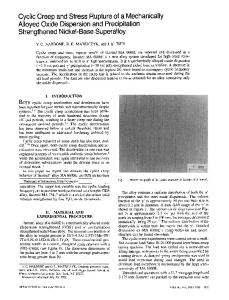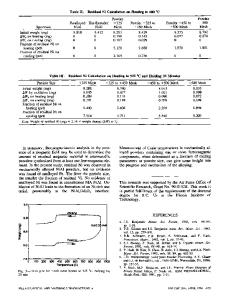Oxide coarsening and its influence on recrystallization in a mechanically alloyed Fe-base oxide-dispersion-strengthened
- PDF / 867,309 Bytes
- 9 Pages / 612 x 792 pts (letter) Page_size
- 87 Downloads / 380 Views
I. INTRODUCTION
THE development of iron-based alloys as an alternative for the more traditional nickel-based superalloys for some components in power plant gas turbine is now well underway. The advantages of using a ferritic stainless alloy instead of a nickel-based alloy in medium temperature applications are readily apparent: not only an iron-based alloy would be considerably cheaper than the nickel counterpart, but a significant improvement could be expected in mechanical properties. These range from a superior strength-to-weight ratio, to a higher melting temperature, which would be expected to give substantially higher creep resistance, to a lower thermal expansion coefficient, which under cyclic heating would rise to less thermal stresses development. An iron-based alloy currently being considered for such an application is a Fe-Cr-Al alloy, mechanically alloyed with yttrium oxide. The oxide dispersion is included to confer greater strength on the alloy, causing substantial directionality in the microstructure upon recrystallization of the alloy. The development of a high directional microstructure has been shown to be extremely important in nickel-based alloys, which are currently used in this application. Wilcox and Claver[1] showed that this type of structure greatly enhanced creep rupture properties, by having fewer grain boundaries along which easy diffusion would be possible in the direction of elongated grains. In order to attain such microstructure in nickel-based alloys (which have been oxide dispersion strengthened) it is necessary to subject the material to a zone annealing heat treatment; isothermal annealing merely produces an equiaxed structure. It has been shown by Schaffer et al.[2] that in a nickel-based alloy, such as INCOLOY* *INCOLOY is a trademark of INCO Alloys International, Huntington Woods, WV.
C. CAPDEVILA, Tenure Scientist, is with the Department of Physical Metallurgy, Centro Nacional de Investigaciones Metalúrgicas (CENIM), Consejo Superior de Investigaciones Científicas (CSIC), 28040 Madrid, Spain. Contact e-mail: [email protected] Manuscript submitted August 20, 2004. METALLURGICAL AND MATERIALS TRANSACTIONS A
MA6000, the oxide dispersion did not coarsen at temperatures up to 850 °C, but that some coarsening did occur when the material was treated at 1100 °C for 1000 hours. This coarsening was via an interface-controlled mechanism, involving Ostwald ripening behavior. Coarsening of this type has been shown to occur much more readily in other systems. It has been shown by Bhattacharyya and Russell,[3] for example, that silica will readily coarsen in a copper matrix at temperatures below 1000 °C after only a 24 hour treatment. It had been suggested that such coarsening behavior may well occur in the ferritic steel, yttrium oxide system, and that this could be responsible for triggering the highly directional microstructure, observed even under isothermal recrystallization heat treatments. The aim of this work was to deduce whether yttria readily coarsen in a ferritic matrix. Fur
Data Loading...











